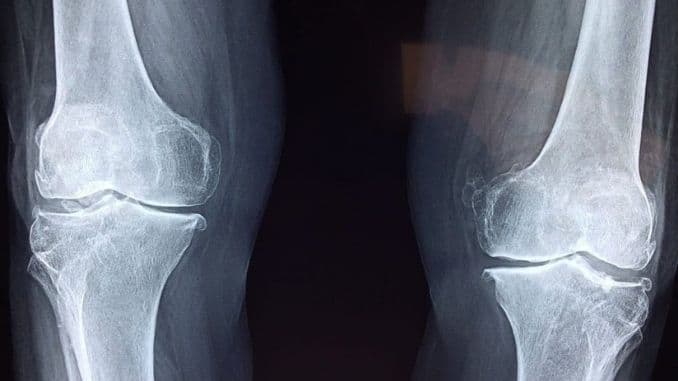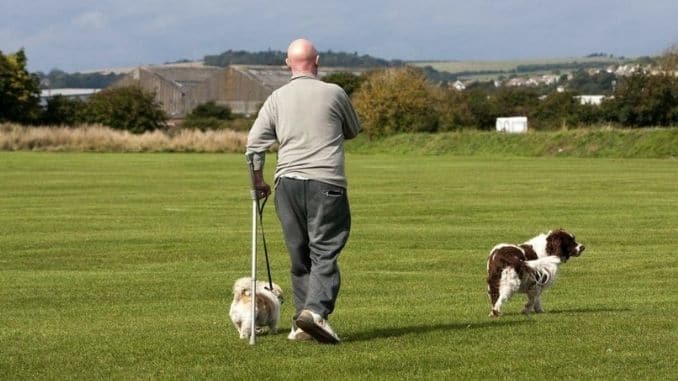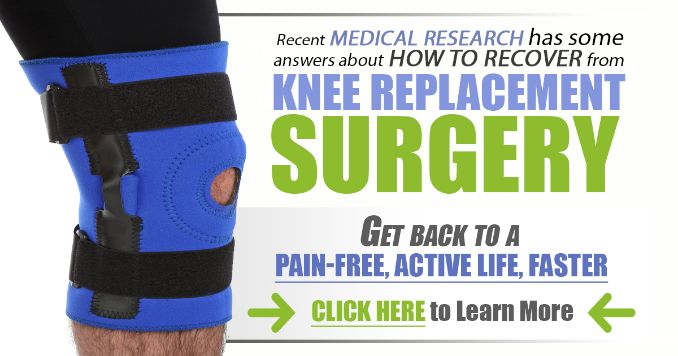
Between the year 2000 and 2010, the rate of total knee replacements performed in the United States nearly doubled for men and women. Among men, the rate increased by 86 percent and among women by 99 percent. In 2010 alone, there were nearly 700,000 replacements completed in adults 45 years and older.
The good news is that the majority of these operations are successful and improve the lives of patients. The American Academy of Orthopedic Surgeons says that 90 percent of people who have a knee replacement experience a dramatic reduction of knee pain and a significant improvement in the ability to go about the activities in their daily lives.
Even better news is that the majority of these implants last for 20 or more years after they’re put into place, allowing seniors to maintain high levels of activity far into their golden years. Researchers discovered in one study that 80-year-olds without knee replacements rated 6 out of 10 on an activity level scale while those who’d had knee replacements 20 years earlier had an average score of 8.3 — indicating that they were still very active and engaged in things like golf, swimming and riding a bike.
These study results were obtained from data of knee replacements completed between 1975 and 1989. Today’s replacements are much more advanced and more closely matched to a person’s natural anatomy, which means they may last even longer.
So, if your doctor has recommended a knee replacement for you, odds are that it will significantly improve your life. It is important, however, to be as prepared as you can and to take certain precautions to help yourself recover as quickly as possible.
What Is a Knee Replacement?
Medically termed “knee arthroplasty,” knee replacement surgery is recommended when the patient’s natural knee has become so damaged that it causes pain and immobility to the point of interfering with daily life. The most common reason for the surgery is to relieve severe pain caused by osteoarthritis.
In time, arthritis wears away the cartilage cushioning between the thighbone and the shinbone until the bones are actually rubbing against one another, causing pain and stiffness. Rheumatoid arthritis can inflame and thicken the membrane around the joint, damaging the cartilage and leading to the same outcome. A serious knee injury, such as a fracture of the bones around the knee or a tear in the ligaments. It can lead to cartilage damage and a loss of knee joint cushioning.
During knee replacement surgery, the doctor removes the damaged cartilage and smooths away the ragged surfaces at the ends of the thighbone and shinbone. Once everything is ready, he inserts the artificial knee, which is usually made of metal and plastic materials. The “tibial component” has a spike that goes into the shinbone and a plate that supports the “plastic spacer,” and the “femoral component” is cemented or “press-fit” into the thighbone. Finally, the surgeon inserts the plastic spacer in between the two to provide for a smooth gliding surface like the cartilage did before. The surgeon may also work on the kneecap, if necessary.
Once the surgery is completed, you will go through a recovery period, after which you should be able to resume your normal activities. Although most surgeons advise against high-impact activities like jumping or running to prolong the life of the implant.
Preparing Before Surgery Can Help Things Go More Smoothly
To experience your most successful outcome from the surgery, it’s important to prepare beforehand. Several weeks before the surgery is scheduled to occur, consider these suggestions:
- Talk to your doctor about a “before-surgery” exercise program. People who are candidates for knee replacement surgery have typically become less active because of pain and difficult mobility. That means that muscles supporting the knee have become weak. You will need these muscles to support your new knee. So building them up a bit before surgery can make recovery easier. Many orthopedic offices now offer presurgery physical therapy that can help you learn exercises that build muscle without suffering pain. Ask your doctor to recommend such a program for you up to two months before your surgery. Typical exercises include ankle circles, thigh squeezes, sliding your heel toward your buttocks (while lying down on your back) and straight-leg raises. Don’t neglect your arms as having good upper body strength will help you support yourself with crutches or a walker in the few weeks following the surgery.
- Get familiar with post-surgery exercises. You will have a series of exercises you’ll need to regularly perform after the surgery. If you get familiar with them now, they will be easier to do when you’re recovering. Ask your doctor to show you some of the exercises you’ll be doing and start doing them at home as much as you can without hurt yourself.
- Get your home ready. Remember, when you come home from the hospital or rehabilitation center. You’ll likely be using a walker or crutches, and you’ll be getting around a little slowly for a while. To improve your safety. Take the time to rearrange your furniture so you have a clear pathway to those areas you use the most, including your bedroom, bathroom, kitchen, and other rooms in your home. If your bedroom is upstairs, you may want to set up a temporary sleeping area downstairs. Remove throw rugs so they don’t trip you up, get a “shower chair” to put in your shower so you’re not having to stand the whole time and invest in some assistive devices like a long-handled shoehorn. Consider installing safety rails and a raised toilet seat in the bathroom and take a good look at the main chair you use to relax. Is it a favorite recliner? The couch? Ask yourself: Is it easy to get in and out of? Consider getting a lifting chair or at least one that’s taller and easier to step out of. If you don’t have a recliner, get a footstool or ottoman as you’ll need to spend time each day with your legs elevated.
Preparing in these ways before you go in for surgery will help make your recovery much easier. You may also want to prepare family members and work colleagues to be without you for a few weeks. If you don’t have family members nearby who are available. Find help to complete tasks like pet care, mowing the lawn, making meals or cleaning house.
Tips to Help You Recover More Quickly After Knee Replacement Surgery
Most patients who go through knee replacement surgery experience dramatic improvement within weeks. Pain is reduced and mobility returns. You can improve your odds of having a successful and speedy recovery by taking the following steps:
- Work on your breathing. After surgery, your airways will have mucus in them. So it’s important to perform regular deep breathing exercises to help clear them out. When you’re in pain or groggy from anesthesia, your breathing will be naturally shallow. So this is something you’ll have to make a point to do. Your nurse will give you a device called a “spirometer” that measures how much air you’re taking in and will help you reach your breathing goals.
- Be prepared to move right away. The key to a good recovery from surgery is movement as soon as possible. Expect your doctor and nurses to encourage you to start gentle movements the same day of your surgery. You will probably sit up at your bedside with your feet on the floor and practice getting up out of bed and back in safely. You may even get up and walk that day with the help of a walker or certainly the next day. Then, you will gradually increase how far and frequently you walk each day. Within a couple days of surgery, you may be able to progress to a cane or crutches.
- Take your pain medications as instructed. Pain relief after surgery is important as it allows you to get moving sooner, which is key to your speedy recovery. Therefore, it’s important to follow your doctor’s instructions concerning your medication, taking it exactly when you’re supposed to. Don’t wait for the pain to get severe before taking it as that can worsen your ability to exercise and cause stress and inflammation that slows healing. You can also use cold therapy to reduce any discomfort, particularly when you’re reclining, as it will help reduce swelling. Be sure to let your doctor know if the pain medications aren’t working or if you experience unpleasant side effects.
- Keep watch over your incisions. Without the proper care, incisions can become infected after surgery, so it’s important to look at yours every day and keep it clean as it heals. Follow the instructions your surgeon gives you carefully. If you notice signs of infection, call your doctor to be sure everything is OK. Symptoms of an infection may include redness and fever.
- Be diligent about your exercises. Once you leave the hospital, you may transfer to a physical therapy area so you can concentrate on regaining movement in your knee. You may continue therapy in the hospital until you’re ready to go home. Either way, it’s important to focus on completing these exercises as instructed. Usually, your doctor or physical therapist will have goals for you to reach, and when you reach them, you’ll be able to go home. You’ll be doing things like the exercises you did before surgery. Including ankle circles and ankle pumps, straight-leg raises, knee straightening exercises, knee bends and walking. Your physical therapist will help you practice getting in and out of a car too. Eventually, you’ll graduate to climbing stairs, standing knee bends and working with an exercise bike.
Gradually, as you heal, you’ll be able to regain your stability to the point you can go without your walker, cane or crutches. However, because you don’t want to fall, be sure to wait until you’re strong again. A typical time frame for full mobility is about three weeks after surgery. But it’s important to stay with your exercises so you can recover fully. Within six to eight weeks, you should be able to drive again.
Continue to check back in with your doctor as needed and be ready to enjoy a new more comfortable, more active life!
If you are looking for an exercise program to help you or your client recover from a knee replacement, check out the Knee Replacement Handbook, here!




